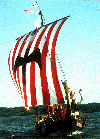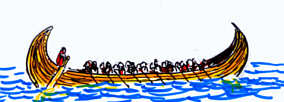|
The origin of the word "viking" is disputed. Through time various theories have been presented of its etymology and its geographical origin. Although research in the Viking Age has been progressive and we now have a more precise knowledge of how people lived 1000 years ago, we do not yet know what the very meaning of the word viking is. The etymology is, however, rather important in order to learn who the Viking was and how he lived.
Clas Brunius follows in 1982 this line in his foreword to "The Frenchmen of the North". He sees the Vikings as a kind of "boat refugees", who were expelled from their homeland and therefore looking for better opportunities across the sea. The most widespread etymology of the word viking is, however, that it is derived from "vik" ("inlet" or "bay") and that its meaning is "pirates dwelling in the inlets". "Pirates from Viken" ("Viken" is an old name for the coast at the Oslo Fjord) is a development of this interpretation. There have also been suggestions that connect the word to the Old Saxon "Wik" ("place of trade"), an interpretation which is preferred by those, in the time of the reassessments, who think that the Vikings mainly were peaceful tradesmen. Even if these hypotheses fulfil linguistic demands, they do hardly, with the exception of Askeberg's interpretation, satisfy the requirement of causality. The Vikings did not dwell in bays or inlets. The flat-bottomed Viking ship was well suited for unexpected landings on open coastlines and according to sagas and historic sources, they preferred to have their bases on islands. When in the 1960's working on an article for "Kulturhistoriskt lexikon foer nordisk medeltid", I met for the first time the word "veckosjoe" (vikusjoe, vika) and associated it immediately with "viking". As far as I know, a linguistic connection between these two words has never been discussed. "Veckosjoe" is an old West Germanic and Nordic sea measure. It actually means "shift at sea" and equals the distance the crew of oarsmen covered before a fresh crew was shifted in. The exact distance has varied with place and time. Upriver in the Kajana River in northern Finland a "veckosjoe" was only 3,6 km. Along the coastline in the southern Baltic it was as an average of 8,3 km. This distance seems reasonable for a shift of oarsmen with a boat like the Viking ship. Place names in the Swedish archipelago remind us even today of the shift of sweaty oarsmen. By tradition one shifted at easily recognizable places, one "veckosjoe" apart. Such places from different times are e. g. "Ombyteshaellen", "Skiftesgrundet" and maybe "Viksten" and "Vaexlet". As there was no exact measuring of time, this system was more fair than a subjective estimate of the length of the rowing turn.
According to Fritz Askeberg, there could be a linguistic connection between "viking" and "vika", the Swedish word for "turn" or "fold". However "vika" and "vecka" (Swedish for "week") are also related, even if "vecka" has a short vowel in its first syllable. When one shifted oarsmen at sea, one "vek vid aarorna" ("turned by the oars") and this was done for every "veckosjoe" (the distance above). An interesting parallel to this, is the English "turn", meaning "shift" which also exists in the Swedish "toern" with the same meaning. Where Askeberg gives priority to the interpretation "one who is departing from his country", I would suggest "one who takes turns by the oars". This suggestion is in my opinion an obvious and interesting possibility. Merely relating to a mean of transportation, it is neutral in the current discussion and reassessment of the role of the Vikings. Having experience from rowing ship boats, e. g. the whaleboats for ten oarsmen in the Swedish Navy, one can easily imagine how the Vikings had to work hard for long periods of time. Therefore they might well have called themselves vikings, meaning "shift-rowers". Jens Rosing writes in "Bogen om Groenland" that about 1530 wreckage was found in Iceland, probably originating from Greenland. Among other things was found an oar with the runic inscription: "Often I was tired when I pulled you". The word viking is older than what we know as the Viking Age, i. e. 800-1050. Already in the ninth century, "Viking" as a man's name is known from a runic stone in the province "Oestergoetland" in Sweden. The word existed in West Germanic languages before what we call the Viking Age. It is e. g. known from the Anglo-Saxon poem Widsith from the eighth century; the poem deals with happenings in the sixth and seventh centuries. The actual concept of "viking raids" has been mentioned in literature long before the Viking Ages. Hostile incursions with rowing boats were common in the West Germanic area, the British Isles, the North Sea coasts and in the southern Baltic, already in the period of the great migrations. The viking ship is also older than the Viking Age. At the exhibition at the Museum of History in Stockholm in 1980, finds from Sutton Hoo, Vendel and Valsgärde showed typical viking ships from the latter period of the great migrations. To these finds one can add the Nydam boat, found in Schleswig, dated from AD 350-400. This boat has 14 pairs of oars and a steering oar on starboard side astern. At Sutton Hoo in 1939 fragments of a viking ship were found in a burial mound. This ship is 27 m long and has 20 pairs of oars. In a purse gold coins were found, the youngest from approx. 620. Examinations have shown that the ship had been repaired and thus not built for the burial. The scientists have not been able to tell the origin of the ship. All these archaeological boat finds have no mast arrangements.
If the original meaning of "viking" is a shiftworking oarsman, the Viking Age is older and longer than one till now considered. Neither is it an exclusive Nordic period, although the Nordic Viking Age is the culmination and the end of a fascinating era. Ship building technology and a crew well organized for sailing these rowing ships in open sea, upstream the Russian rivers or against the tide in the Channel were required conditions for the communications, which enabled distant colonizations by the Nordic Vikings. At the same time, the goods and the new ideas the Viking expeditions brought back meant much for the development of the Nordic countries. As time passed by, the rhythmic and hard work by the oars did no longer pay
off. The last shift lifted their oars and the dragon ships were pulled
ashore on the rocky shores. Soon the struggle was forgotten and so was the
background for naming those who struggled. ReferencesAskeberg, F. 1944. Norden och kontinenten i gammal tid. Uppsala. Bornemann, C. och Petersen. H.. ed. 1970. Bogen om Grønland. København. Håsum. S. 1974. Vikingatidens segling och navigation. Theses and papers in Northeuropean archaeology. Stockholm. |
 In
1944 Fritz Askeberg came up with an interesting theory in his book
"Norden och kontinenten i gammal tid". Askeberg means that the word is
older than what we today call the Viking Age but though of Nordic origin.
His opinion is that "Viking" probably is derived from Old Norse "vikja" (differ,
deviate) and that it may have meant "one who goes away", i. e. leaves the
country or "one who goes abroad".
In
1944 Fritz Askeberg came up with an interesting theory in his book
"Norden och kontinenten i gammal tid". Askeberg means that the word is
older than what we today call the Viking Age but though of Nordic origin.
His opinion is that "Viking" probably is derived from Old Norse "vikja" (differ,
deviate) and that it may have meant "one who goes away", i. e. leaves the
country or "one who goes abroad". It
is not surprising that old measures at sea express the distance covered
during a specific period of time; when rowing and sailing. This principle
was also practised on land. A distance could e. g. be given as a number of
days march. In the Swedish "Oestgoetalagen" ("draapmaalsbalken, flock 11")
"vika at vatne" is equalled to "rost (raest) at lande". A "rast" is the
distance one walked between resting places.
It
is not surprising that old measures at sea express the distance covered
during a specific period of time; when rowing and sailing. This principle
was also practised on land. A distance could e. g. be given as a number of
days march. In the Swedish "Oestgoetalagen" ("draapmaalsbalken, flock 11")
"vika at vatne" is equalled to "rost (raest) at lande". A "rast" is the
distance one walked between resting places.
 Åter till Marinarkeologi
Åter till Marinarkeologi